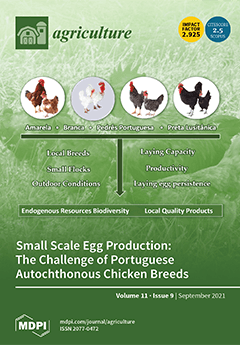Berry dropping or shattering is an important factor during the harvest and post-harvest handling of fresh eating grapes until they reach the supermarkets. There are a lot of methods to measure post-harvest placing damage and the detachment force for single fruits. However, until now, there has been no objective method to observe and analyze the berry dropping mechanism of cluster fruits during robotic post-harvest handling. Therefore, in this paper, the effect of a cluster’s vibration on berry drop during vertical transportation and the impact of different packaging materials on fresh grape clusters during robotic placing were analyzed. For this purpose, a lead screw lathe, along with an attached actuator, three grape cluster samples (0.48, 0.50, 0.53 kg), three packaging materials (rigid plastic box, corrugated fiberboard box, expandable polystyrene box), four transportation speeds (0.4, 0.6, 0.8, 1.0 m/s), and four acceleration excitations (6, 8, 10, 12 m/s
2) that were given in a mechanical system (actuator) were studied. In order to analyze the berry drop mechanism of grape clusters before and after the impact with packaging material, a force sensor and high-speed video camera were used. It was concluded from the vertical transportation test that with the increase in speed and acceleration excitations, the change in hanging force increased positively (
R2 = 0.92). Additionally, the force after the striking of the grape cluster with packaging materials decreased negatively (
R2 = 0.97), and the corresponding index of berry deflection increased. It was also observed from the high-speed camera images that rigid plastic boxes caused the maximum deflection of the grape berries, with the highest change in force of 8.6 N after the impact. Experimental results showed a negative correlation between the hanging force signals and the force after impact of the cluster, with a goodness of fit of
R2 = 0.95 at different speeds. Overall, the proposed findings can be used as a reference study for improving robotic post-harvest handling, providing a useful visual and technical understanding of the berry fall susceptibility of cluster fruits, and can be used to develop a post-harvest robotic placing tool for avoiding berry drop damage on both industrial and farm levels.
Full article





